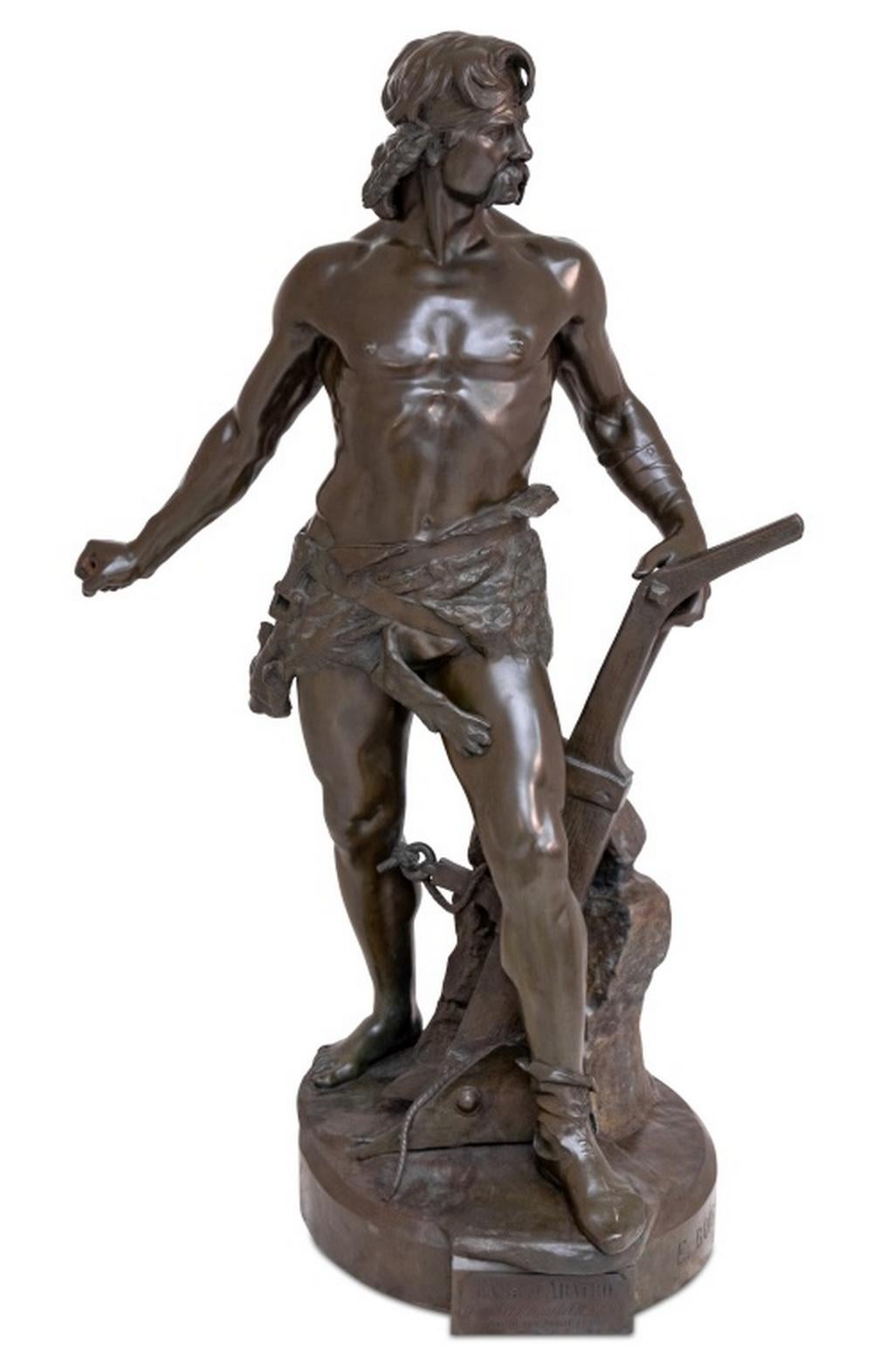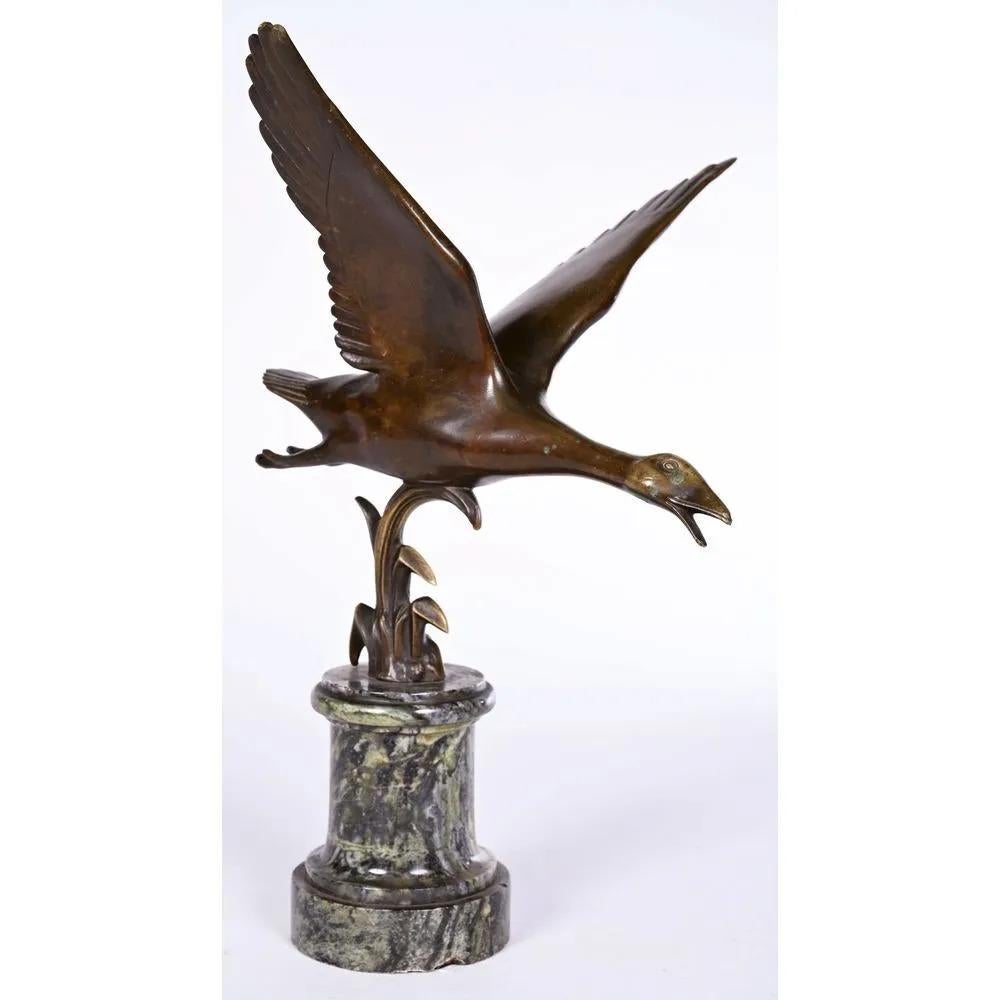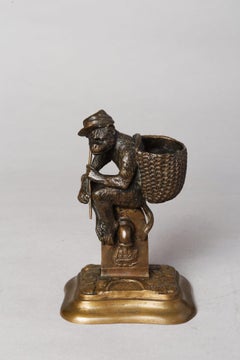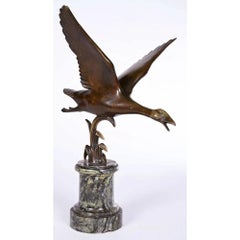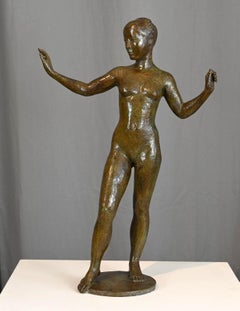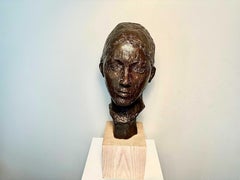Articoli simili a Centaur abducting a woman
Vuoi altre immagini o video?
Richiedi altre immagini o video al venditore
1 di 15
Aimé-Jules DalouCentaur abducting a womancirca 1895-1902
circa 1895-1902
Informazioni sull’articolo
Centaur abducting a woman
by Aimé-Jules DALOU (1838-1902)
A bronze group sculpture with a dark brown patina
Signed on the base "Dalou"
Cast by "A.A. Hébrard" (with the foundry stamp)
The casts by Hébrard are always the finest ones regarding Dalou's works. Perfect in quality of cast and patina.
France
posthumous cast around 1910
height 27 cm
width 21 cm
depth 15,5 cm
A similar model reproduced in "Jules Dalou, le sculpteur de la République", Exhibition held at the Musée du Petit Palais, Paris, 2013, page 415, n°337.
Biography :
Aimé-Jules Dalou, said Jules Dalou (1838-1902) was a French sculptor, born from Protestants glovers craftsmen who raised in secularism and love of the Republic. Jules Dalou was very young talented for modeling and drawing, which earned him the attention of Jean-Baptiste Carpeaux, who made him entered in 1852 in the Little School, the future National School of Decorative Arts in Paris. In 1854, he was admitted to the School of Fine Arts in Paris, where he studied painting in the workshop of Abel de Pujol and sculpture in the workshop of Francisque Duret. He began to earn his living by working for decorators, and began his friendship with Auguste Rodin. Dalou then produced decorative sculptures for buildings on major Parisian avenues, such as the Hotel de la Paiva, on the Champs-Elysees Avenue. He presented but failed four times to Rome prize competition, but exhibited at the 1869 Salon his "Daphnis and Chloe" and the "Embroiderer" at the Salon of 1870, two pieces acquired by the French state. Dalou had one child, Georgette, a girl born with a mental handicap. This is to ensure funding for her daughter's life accommodation in the Orphanage of Arts, that Dalou bequeathed the funds from his workshop to this institution.
After the bloody week of May 1871 Dalou, his wife and their daughter were threatened as Communards, forced into exile and requested asylum. They then joined England and were greeted by his former fellows of the Little School, the painter Alphonse Legros. With Legros, much introduced in the City, he made a serie of terracotta statuettes inspired by boulonnaise peasants or intimate subjects (readers, lullabies), and portraits of the English aristocracy. He became professor for modeling at the National Art Training School, his influence was decisive for many British sculptors. He received orders for a public fountain in marble titled "Charity" (1877) near the Royal Exchange in London, and a monument dedicated to Queen Victoria's grandchildren located in the private chapel of Frogmore at Windsor Castle.
In May 1874, the Paris War Council condemned Dalou in absentia to hard labor for life. Having refused to beg for mercy, he was only in May 1879 being granted amnesty and his family finally returned from exile. His group "The Triumph of the Republic", originally planned for the Place de la Republique in Paris, was finally erected on the Place du Trône, renamed Place de La Nation in 1880. Dalou devoted twenty years to the realization of this monument. The years 1881 and 1882 were difficult, but the 1883 Salon finally revealed him to the French public. He exhibited his two high reliefs: "The Brotherhood of Peoples" and "Mirabeau answering Dreux-Brézé", for which he was awarded the Medal of Honor. Fleeing the world and living in family, Dalou engaged in considerable work and many orders both private and public. For the Universal Exhibition of 1889, was inaugurated on the Place de la Nation the plaster of "The Triumph of the Republic" commissioned by the city of Paris in 1879. Although the bronze version of the group was inaugurated in 1899, this work won the grand prize for sculpture in the exhibition. Dalou left the French Society of Artists in 1890 to expose at the National Society of Fine Arts, of which he was a founding member with Ernest Meissonier, Auguste Rodin and Pierre Puvis de Chavannes. Awarded Knight of the Legion of Honor in 1883, and promoted to officer by President Carnot in 1889, he was elevated to the rank of Commander of the same order in 1899 by President Loubet at the inauguration of the monument of "The Triumph of the Republic".
Dalou had no time to complete his last great project, a monument dedicated to workers, the idea came to him in 1889 after the first opening of "TheTriumph of the Republic". The formality of the ceremony and military parades held the people away from the official event. Dalou was disappointed. True to its republican ideals, he had hoped that this inauguration was an opportunity of great popular democratic party (as it was at the inauguration of the bronze in 1899). His idea was then to pay tribute to the world of workers, craftsmen and peasants with this work being the central subject. At the end of his career Dalou described the project as follows: "I think I have finally found the monument to the workers that I seek since 1889. Sober, without molding or ornament, I wish it'd be severe and imposing. Will I execute it? There is the question. I am old and my health is so weak."
- Creatore:Aimé-Jules Dalou (1838 - 1902, Francese)
- Anno di creazione:circa 1895-1902
- Dimensioni:Altezza: 27 cm (10,63 in)Larghezza: 21 cm (8,27 in)Profondità: 15,5 cm (6,11 in)
- Tecnica:
- Movimento e stile:
- Periodo:
- Condizioni:
- Località della galleria:PARIS, FR
- Numero di riferimento:Venditore: N.X1stDibs: LU2514216390642
Informazioni sul venditore
5,0
Venditore riconosciuto
Questi venditori prestigiosi sono leader del settore e rappresentano il massimo in termini di qualità e design.
Fondazione nel 1992
Venditore 1stDibs dal 2023
7 vendite su 1stDibs
Tempo di risposta standard: 14 ore
- SpedizioneRecupero del preventivo…Spedizione da: PARIS, Francia
- Politica di reso
Alcune parti di questa pagina sono state tradotte automaticamente. 1stDibs non può garantire che le traduzioni siano corrette. L’inglese è la lingua predefinita del sito.
Garanzia di autenticità
Nell’improbabile caso in cui si verifichi un problema con l’autenticità di un articolo, contattaci entro un anno per ottenere un rimborso completo. DettagliGaranzia di rimborso
Se il tuo articolo non corrisponde alla descrizione, è danneggiato durante il trasporto o non arriva, contattaci entro 7 giorni per un rimborso completo. DettagliAnnullamento entro 24 ore
Hai un periodo di tolleranza di 24 ore per annullare il tuo acquisto, senza necessità di fornire spiegazioni.Venditori professionali selezionati
I nostri venditori di livello internazionale devono aderire a rigorosi standard di servizio e qualità, garantendo l’integrità delle inserzioni.Garanzia miglior prezzo
Se scopri che un venditore ha pubblicato altrove lo stesso articolo a un prezzo più basso, applicheremo lo stesso prezzo.Consegna globale affidabile
La nostra rete di vettori leader del settore offre opzioni di spedizione specializzate in tutto il mondo, inclusa la consegna personalizzata.Altro da questo venditore
Mostra tuttoPorta fiammiferi a forma di scimmia
Di Christophe Fratin
Porta fiammiferi a forma di scimmia
di Christophe Fratin (1801-1864)
Bronzo con patina marrone sfumata
Firmato sulla base "Fratin
Vecchia edizione del cast
Francia
1850 circa
alte...
Categoria
Metà XIX secolo, Scuola francese, Sculture figurative
Materiali
Bronzo
Giovane donna seduta con drappeggio
Giovane donna seduta con drappeggio
di Pierre Marie POISSON (1876-1953)
Scultura in bronzo con patina verde sfumata
firmato sulla base "P. Poisson"
vecchio calco
Francia
circa 193...
Categoria
Anni 1930, Scuola francese, Sculture (nudo)
Materiali
Bronzo
Le tre grazie
Le tre grazie
di Alfred JANNIOT (1889-1969)
Un gruppo in bronzo con una patina marrone-verde sfumata
Firmato sul lato della base "A. Janniot"
Fuso da "Susse fondeur Paris" (con il m...
Categoria
Metà XX secolo, Scuola francese, Sculture figurative
Materiali
Bronzo
34.944 USD
Maternità
Di Baltasar Lobo
Maternità
di Baltasar Lobo (1910-1993)
Un gruppo in bronzo con una patina verde brunastra
Firmato in basso sul davanti "Lobo".
Fuso da "Susse Fondeur Paris" (con il marchio della fo...
Categoria
Metà XX secolo, Scuola francese, Sculture figurative
Materiali
Bronzo
55.911 USD
Gorilla che rapisce una donna
Di Emmanuel Fremiet
Emmanuel Fremiet (1824-1910)
Gorilla che rapisce una donna
Un raro gruppo in bronzo con una patina marrone scuro verdastra
firmato "E. Fremiet" sulla base
fuso da " F. Barbedienne ...
Categoria
Fine XIX secolo, Scuola francese, Sculture figurative
Materiali
Bronzo
Cervo che cammina N.2
Di Antoine-Louis Barye
Cervo che cammina N.2
di Antoine-Louis Barye (1796-1875)
Bronzo con patina marrone scuro e verdastro
firmato sulla base "Barye
vecchio calco probabilmente di Brame
Francia
circa 1...
Categoria
Anni 1880, Scuola francese, Sculture figurative
Materiali
Bronzo
Ti potrebbe interessare anche
Emile Boisseau "Ense et Aratro" in bronzo patinato per Tiffany & Co.
Emile Andre Boisseau (francese, 1842-1923) "Ense et Aratro" [Con la spada o con l'aratro] Scultura in bronzo patinato, venduta da Tiffany & Co. alla fine del XIX secolo, il guerriero...
Categoria
Fine XIX secolo, Scuola francese, Sculture figurative
Materiali
Bronzo
Bronzo Art Déco raffigurante un'Oie, Les Ailes Déployées
Bronzo Art Déco raffigurante un'oie, con le ailes dispiegate. È di una bella patina bruna. Socle en marbre vert. Signé de LUC. H.31 L.21.
Categoria
Anni 1920, Scuola francese, Sculture figurative
Materiali
Bronzo
Marie
Jacques Coquillay (nato nel 1935)
Marie
Bronzo originale
Dimensioni: 56x39x17cm
Copia n. 4/8
Firma e numero sulla base.
Bronzo originale realizzato a "cera persa"
L'edizione dei b...
Categoria
Inizio anni 2000, Scuola francese, Sculture (nudo)
Materiali
Bronzo
9.318 USD
Donna sconosciuta
Ispirato alla testa di Apollo di Antoine Bourdelle. Una donna con un'espressione forte e decisa, ma allo stesso tempo vulnerabile.
Categoria
Anni 1980, Scuola francese, Sculture figurative
Materiali
Bronzo
4.251 USD
"Le Chanteur Florentine"
Di Paul Dubois
Dopo Paul Dubois (francese, 1829-1905) "Le Chanteur Florentin" [Il cantante fiorentino] Scultura in bronzo patinato, il cantante in piedi appoggiato su un piedistallo mentre suona un...
Categoria
Fine XIX secolo, Scuola francese, Sculture figurative
Materiali
Bronzo
Antique French Polish Gilt Bronze Statue Sculpture Figure Sword Bladesmith 1890
Un'antica scultura francese in bronzo dorato raffigurante un fabbro spadaccino, opera dell'artista e scultore franco-polacco Henryk II Kossowski (1855-1921), il bronzo risale al 1890...
Categoria
Anni 1890, Scuola francese, Sculture figurative
Materiali
Alabastro, Bronzo
